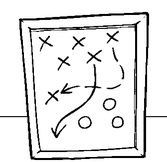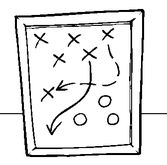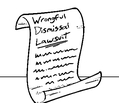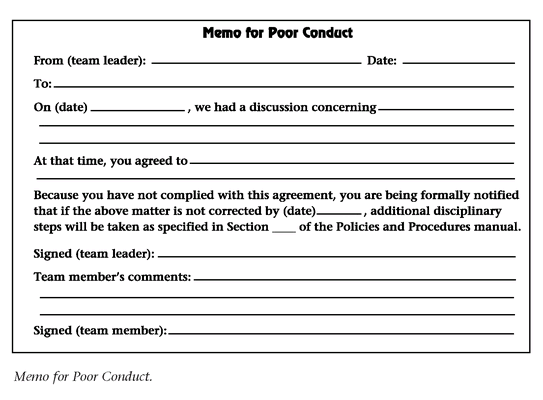
Chapter 23
Doling Out Discipline
In This Chapter
➤ A systematic approach to discipline
➤ Making reprimands effective
➤ Punishment: probation and suspension
➤ Documentation: your first line of defense
When you hear or see the word discipline, the first thing that usually pops into your mind is punishment. Look at that word again. Notice that by dropping just two letters in the last syllable (i and n), it turns into disciple, which is a synonym for “student.” Both words are derived from the Latin word disciplina, meaning “to learn.” If you look at discipline not as punishment, but as a means of learning, both you and your employees will benefit. Look at yourself as the coach and your employees as the learners. In this chapter we’ll look at the formal approaches to discipline that most organizations use.
The Typical Disciplinary System
When an employee violates company rules, most companies follow a standard procedure to try to get him or her back on track. If this doesn’t succeed, they generally punish the offender. This usually is referred to as progressive discipline.

Meanings and Gleanings
Progressive discipline is a systematic approach to correcting rule infractions. A typical program has six steps, beginning with an informal warning. If the warning doesn’t succeed, the following steps are taken, in order: disciplinary interview, written warning, probation, suspension, and termination (if necessary).
Typically, progressive discipline is a six-step procedure as follows:
1. An informal warning or reprimand The supervisor talks to the offender, usually at his or her workstation; discusses the problem, and cautions that the behavior should not be repeated.
2. A formal disciplinary interview This usually is held in the supervisor’s office or a conference room. The offender is put on notice that future violations will not be tolerated.
3. A written warning This step sometimes is included as part of the formal disciplinary interview. Copies are placed in appropriate files.
4. Probation The employee is given a specified period of time to shape up and get back on track.
5. Suspension The employee is suspended without pay for a specified period of time.
6. Termination The end of the line. This will be discussed in detail in Chapter 25, “How to Fire an Employee Legally and Tactfully.”
Now let’s look at how these steps are implemented.
Effective Reprimands
When you, the manager, note a violation of rules—let’s say tardiness—you call it to the employee’s attention in a casual way. These chats are friendly but firm, and are not part of the progressive discipline procedure. However, because it may lead to more formal action, it’s a good idea to make a note of it in your department records. Although this note is not placed in the employee’s personnel file, it can be helpful to prove a pattern of behavior if needed.
The first official step in the progressive discipline system often is called the oral, or verbal, warning. In this step, you take the offender aside and remind him or her that the two of you have previously discussed the problem with lateness. Because this behavior has been repeated, you are officially asserting that tardiness cannot be accepted. Make clear what steps you’ll take if the behavior continues.
You might be exasperated about one of your group’s failure to keep a promise to be on time. It’s normal to be annoyed if your team’s work is delayed—but don’t lose your cool. Here’s how you should not do it:
You (angrily): How many times do I have to tell you that we need you here at 8 o’clock? You know that we have a deadline to meet today. Haven’t you any sense of responsibility?
Employee (annoyed): I was only ten minutes late. It’s not my fault. I ran into a traffic problem.
You: If you had left home early enough, you wouldn’t have had a traffic problem. The rest of us were here on time. You just don’t have a sense of responsibility.
Employee: I have as much of a sense of responsibility as anyone.
You: If you’re late again, I’ll write you up.
Did this conversation solve anything? The objective of an informal warning is to alert team members that a problem needs correction. By using an angry tone and antagonistic attitude, you only rile the person without solving the problem.
Let’s replay that reprimand in a better way:
You: You know how important it is for you to be here when the workday begins. The entire team depends on all of us being on time.
Employee: I’m sorry. I ran into unusual traffic this morning.
You: We all face traffic in the morning. What can you do to make sure that you’ll be on time in the future?
Employee: I’ve tried alternative routes, but it doesn’t help. I guess I’ll have to leave earlier every day so that, if I do run into traffic, I’ll at least have a head start.
You: That sounds good to me. You’re a valuable member of our team, and being on time will help all of us.

Personnel Perils
Never reprimand people when you’re angry, when they’re angry, or in the presence of other people. Reprimands should be a private matter between two calm people working together to solve a problem.
When you’re preparing to reprimand someone, to ensure that you conduct the reprimand in the most effective manner, study the following guidelines:
➤ Time the reprimand properly. As soon as possible after the offense has been committed, call the offender aside and discuss the matter in private.
➤ Never reprimand when you’re angry. Wait until you’ve calmed down before talking to the employee.
➤ Emphasize the what, not the who. Base the reprimand on the action that was wrong, not on the person.
➤ Begin by stating the problem, and then ask a question. Don’t begin with an accusation, “You’re always late!” Say instead, “You know how important it is for all of us to be on the job promptly. What can you do to get here on time from now on?”
➤ Listen. Attentive, open-minded listening is one of the most important factors of true leadership. Ask questions to elicit as much information about the situation as you can. Respond to the offender’s comments, but don’t let the interview deteriorate into a confrontation.
➤ Encourage the employee to make suggestions for solving the problem. When a person participates in solving a problem, there’s a much greater chance that it will be accepted and accomplished.

Tactical Tips
If an employee raises his or her voice, lower yours. Most people respond to a raised voice by raising their own. By responding in a soft voice, you disarm the other person. It has a calming effect.
➤ Provide constructive criticism. When possible, give him or her specific suggestions about how to correct a situation.
➤ Never use sarcasm. Sarcasm never corrects a situation; it only makes the other person feel inadequate and put upon.
➤ End your reprimand on a positive note. Comment on some of the good things the person has accomplished so that he or she knows that you’re not focusing only on the reason for this reprimand, but on total performance. Reassure the person that you look on him or her as a valuable member of the team.
Asking for a Plan of Action
When you deliver an oral warning, throw the problem back to the employee. Rather than saying, “This is what you should do,” ask, “What do you think you can do to correct this situation?” Get people to come up with their own plans of action.
In a simple situation such as tardiness, a plan of action is relatively easy to develop: “I’ll leave my house 15 minutes earlier every day.” In more complex situations, a plan might take longer to develop. You might suggest that the person think about the problem for a day or so and arrange a second meeting in which to present and discuss it.
Documenting a Reprimand
Even informal reprimands shouldn’t be strictly oral. You should keep a record of them. Legal implications mandate that you document any action that could lead to serious disciplinary action. Some team leaders document an informal warning by simply noting it on their calendars or entering it in a department log. Others write a detailed memo for their files. Use the technique your company prefers.
Disciplinary Actions
If an employee repeats an offense after receiving a verbal warning, the next step is the more formal disciplinary interview. In some systems the written warning is given as part of this step; in others it is a separate step given if the employee repeats the offense.
The disciplinary interview differs from a reprimand in that it is more formal. The verbal reprimand usually is a relatively brief session, often conducted in a quiet corner of the room. Conversely, a disciplinary interview is longer and is conducted in an office or conference room.
A disciplinary interview should always be carefully prepared and result in a mutually agreed-upon plan of action. Whereas a plan of action following a verbal warning usually is oral, the resulting plan in a disciplinary interview should be put in writing. This not only reminds both the supervisor and the employee of what has been agreed on; it serves as documentation.

Tactical Tips
An alert and observant manager can anticipate problems before they develop. Be alert to any deviations from standards before they become problems. By dealing with rule infractions early on, disciplinary procedures can be averted.
To ensure that the disciplinary interview is carried out systematically, use the following discipline worksheet.
When administering the disciplinary interview, follow the same guidelines as suggested for the reprimand. However, this is a more formal meeting; comments, questions, and the suggested plan of action should be written. A copy should be given to the employee, a copy kept in the department file, and a copy sent to the human resources department for the employee’s personnel file. This is important; if any legal action should ensue from the disciplinary action, this report will serve as documentation to support the position of the department and the company.
Similar distribution should be made of any written warnings—whether issued as part of the disciplinary interview or at a later time. Samples of appropriate documents are shown later in this chapter.

Probation and Suspension
Until now, all attempts to correct performance or behavior have been positive. The supervisor has provided advice and counsel. If nothing has worked, the next step is to put the offender on probation. This step gives him or her one more chance to shape up before some form of punishment is invoked. Most people take probation seriously.
Probationary periods vary from as few as 10 days to the more customary 30 days and sometimes even longer. If an employee makes significant progress, the probation can be lifted. If he or she reverts back to the offending behavior after the probation is lifted, you can reinstate the probation or resort to the next step.
One primary reasons for progressive discipline is poor performance. If this is the problem, probation is the last step before termination. If, despite all the retraining, counseling, and coaching, the employee fails, probation is one last chance to overcome the problem during a definite period. If this doesn’t help, suspending the member won’t help, either. If he or she can be transferred to a more suitable job, do so; if not, there is no other choice than to terminate that person.
Until this step in the progressive discipline system, there has actually been no punishment. Each step has been a warning with the implication of potential punishment. If probation hasn’t solved the problem, the most commonly used form of punishment—short of termination—is suspension without pay.
Although supervisors and team leaders often have some leeway in the length of a suspension, most companies set specific suspension times depending on the seriousness of the offense. Because suspension is a very serious step, union contracts often require consultation with a union representative before suspending an employee. Even when companies aren’t unionized, it’s best to require approval for suspensions by both the manager to whom the employee’s supervisor reports and the human resources department.

Personnel Perils
It’s not a good idea to extend a probationary period. If a person makes some progress by the end of the probationary period but his or her behavior still isn’t up to expectations, you can extend the time period—but only once. Continuous probation is bad for morale and rarely solves the problem.

Tactical Tips
The downside of suspending a worker is that the team loses that person’s contribution during the suspension period. Make efforts such as training and counseling to keep the person employed so that suspension isn’t necessary.
Appropriate documentation specifying the reason for the suspension and the exact period of time involved should be made, signed by the appropriate managers, and by the suspended employee. If an employee returns from a suspension and continues to break the rules, your next step might be a longer suspension or even termination.
“If It Ain’t Written Down, It Ain’t Never Happened”
In this litigious age, you never know when a current or former employee will sue you. Keeping good records of all disciplinary actions is your best defense in such cases. In addition, written warnings often are taken more seriously than the reprimands or oral warnings. Employees don’t want negative reports in their personnel files, and even the possibility that they’ll be “written up” serves as a deterrent to poor behavior.
If the written warning concerns poor performance, specify the performance standards and indicate in what way the employee’s performance fell short of the standards. Also state what the company did to help the employee meet the standards. This will protect you against potential claims that you made no effort to help that employee.
If the warning concerns infraction of a company rule, specify the nature of the offense and what disciplinary steps were taken before writing the warning (see the following two sample memos). To protect your company from potential legal problems, check any form letters concerning discipline with your legal advisors before sending them to be printed.


Employee Acknowledgment
Although it’s always advantageous from a legal standpoint to have employees sign all disciplinary documents, it becomes imperative when the warning itself is in writing. However, you can’t force anyone to sign anything. If an employee refuses to sign a disciplinary document, call in a witness—a person not directly involved in the situation—and repeat your request. If he or she still refuses, have the witness attest to that response on the document.
One tough supervisor reported that he never had trouble getting employees to sign a document. If they refused to sign, he’d turn the paper over and slam it onto the desk and order, “Okay, then just write on the back “I refuse to sign” and sign it. They always did.
The Least You Need to Know
➤ Progressive discipline gives employees several opportunities to correct their behavior before punishment is applied.
➤ When reprimanding somebody, stay cool, be constructive, and focus on the problem, not the person.
➤ Prepare carefully before conducting a disciplinary interview. Get a plan of action from the employee on how the problem will be resolved.
➤ All disciplinary actions should be documented.
..................Content has been hidden....................
You can't read the all page of ebook, please click here login for view all page.
